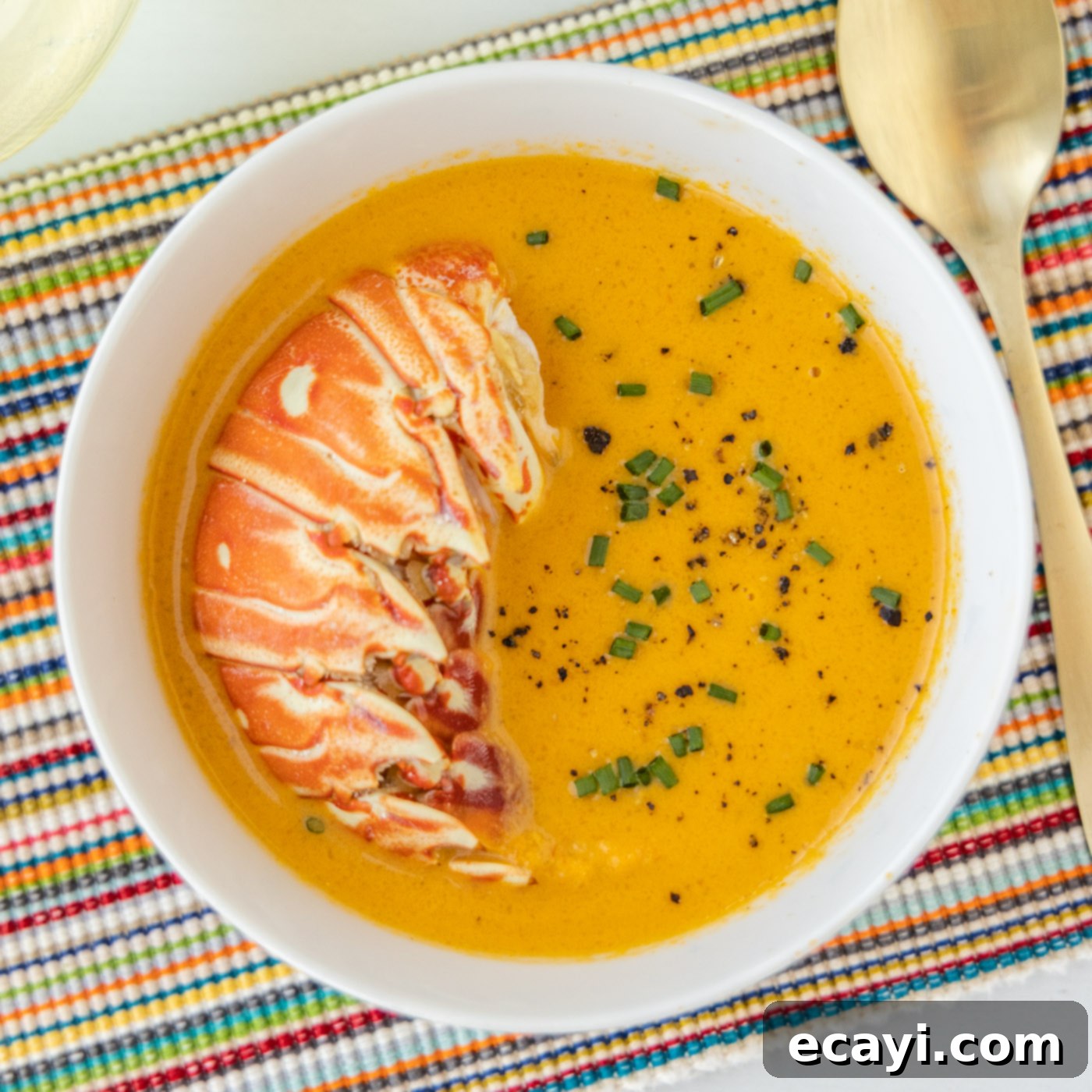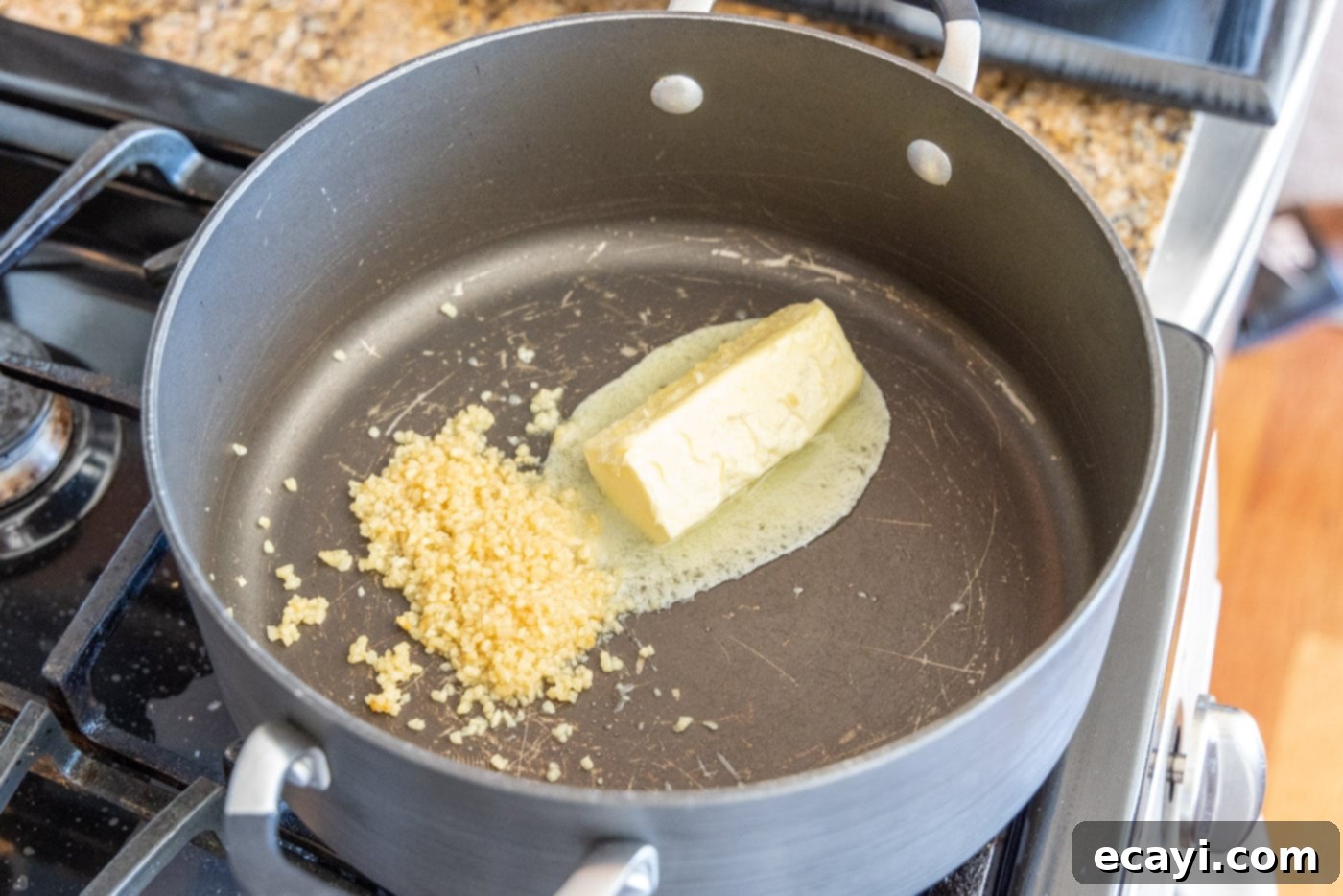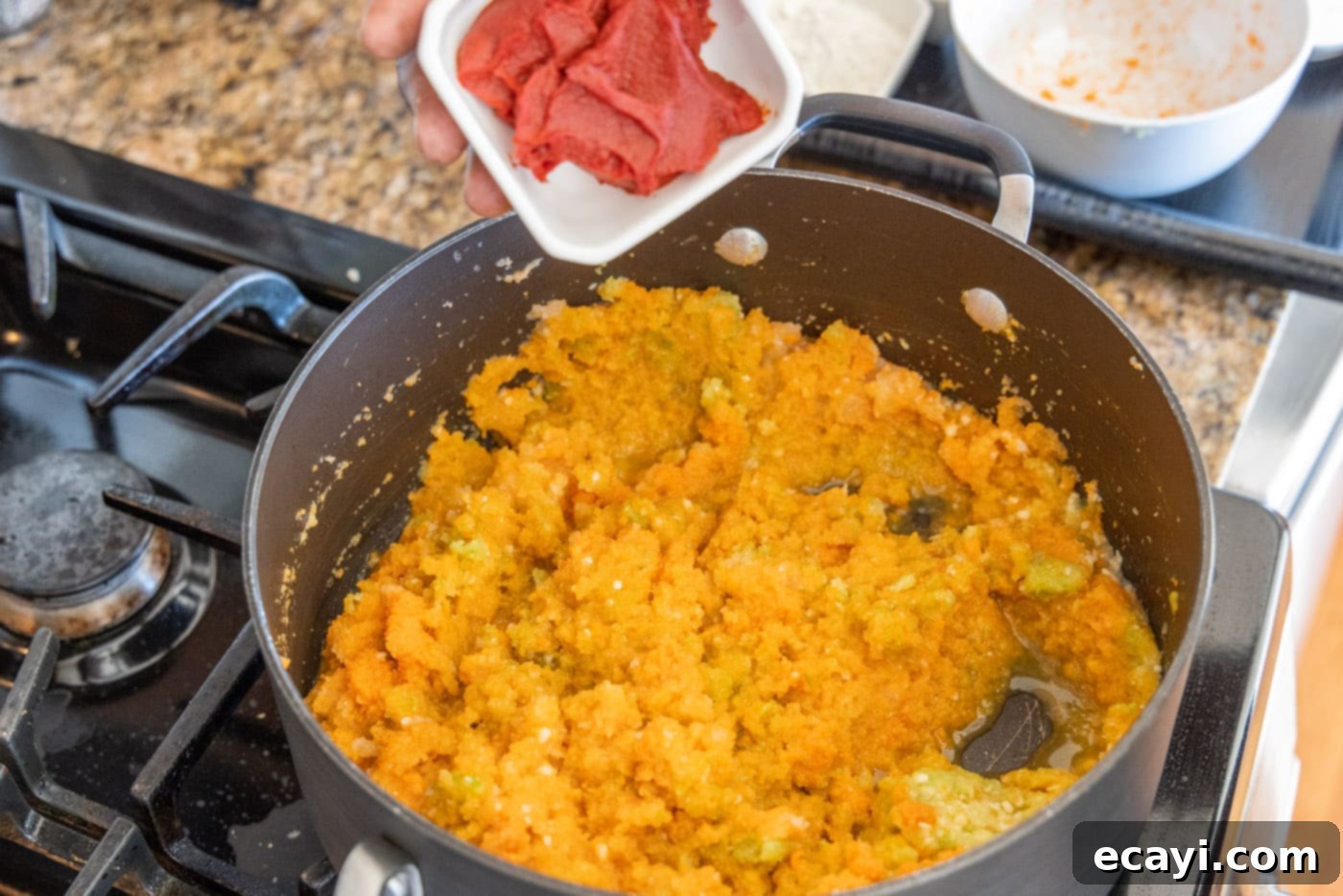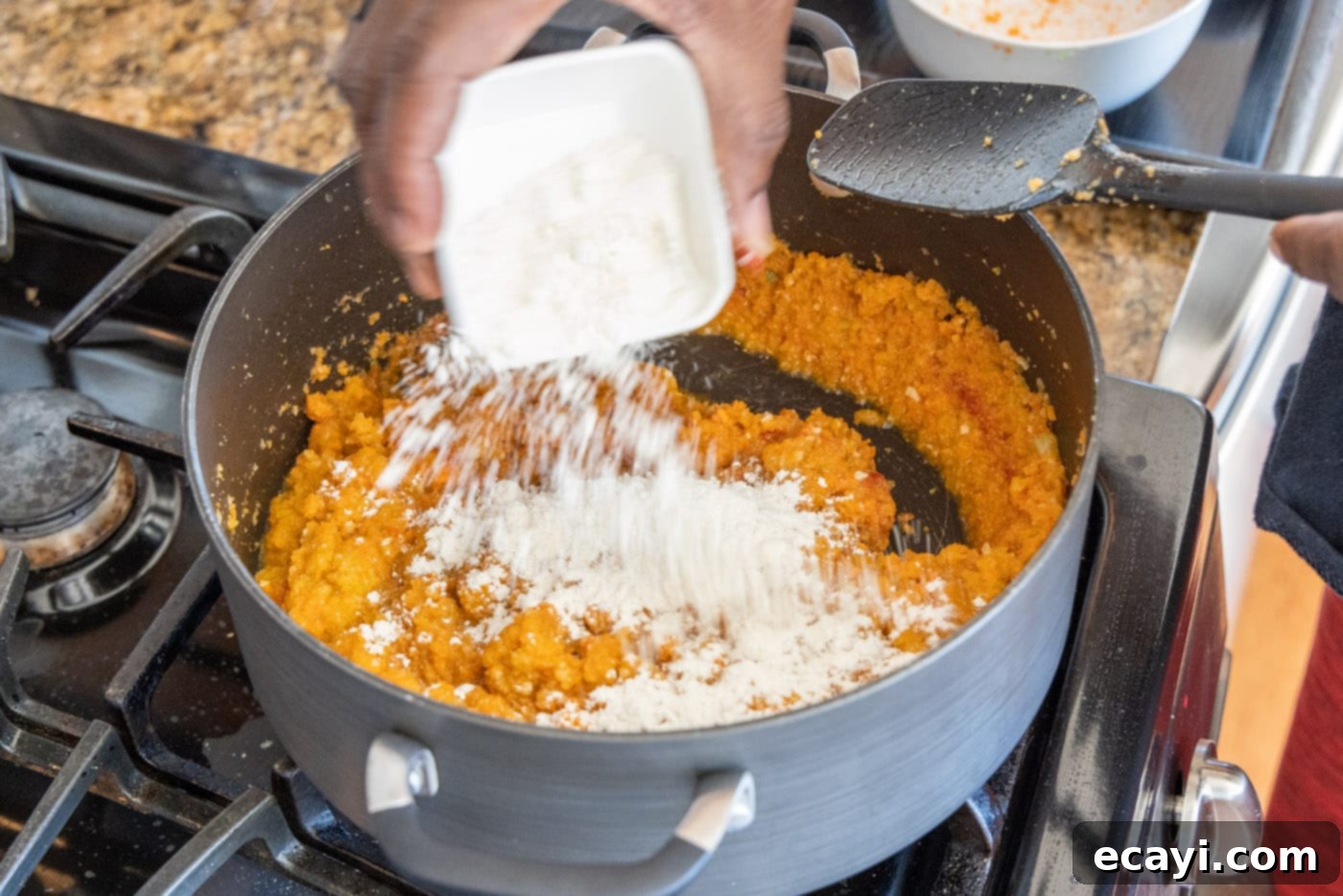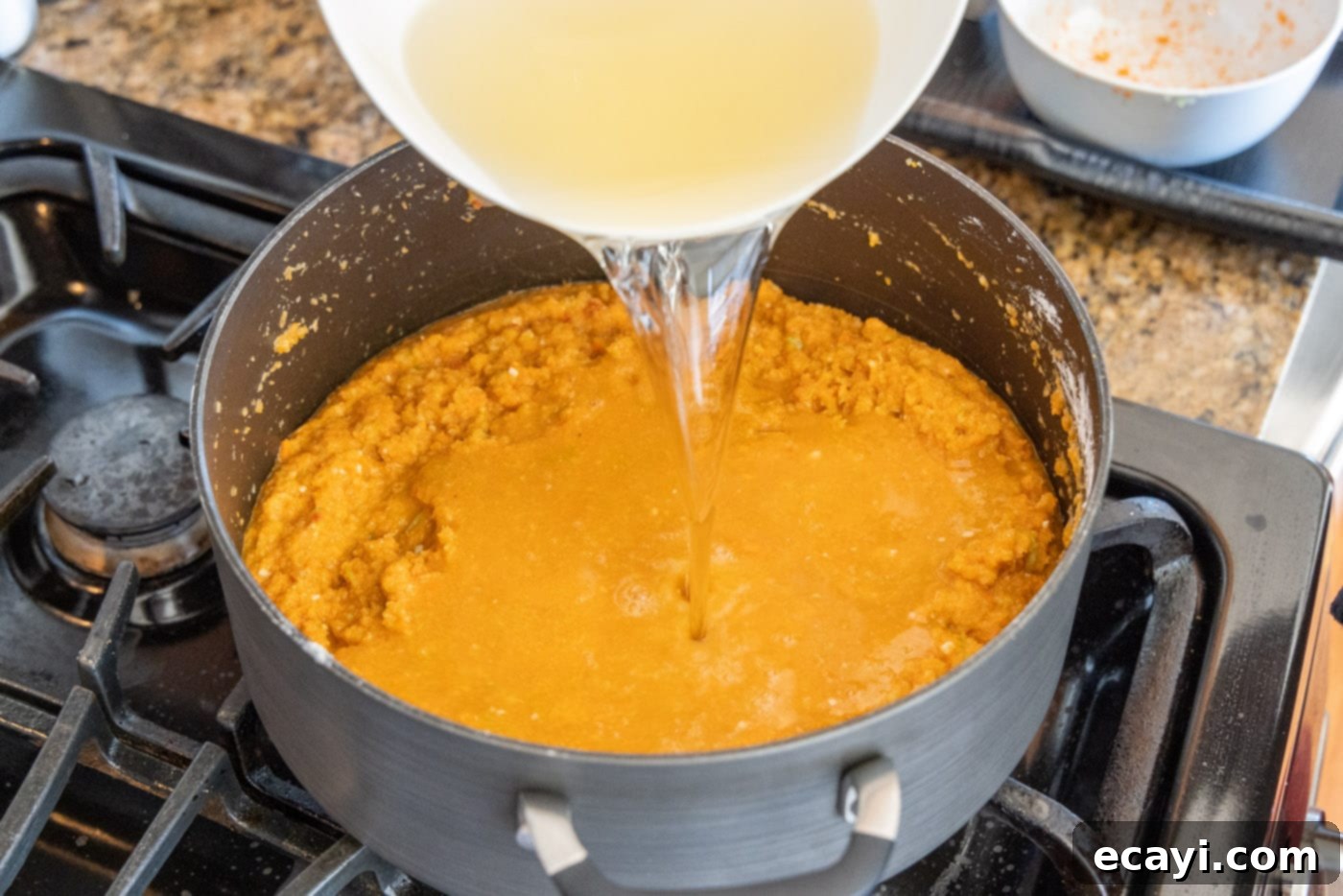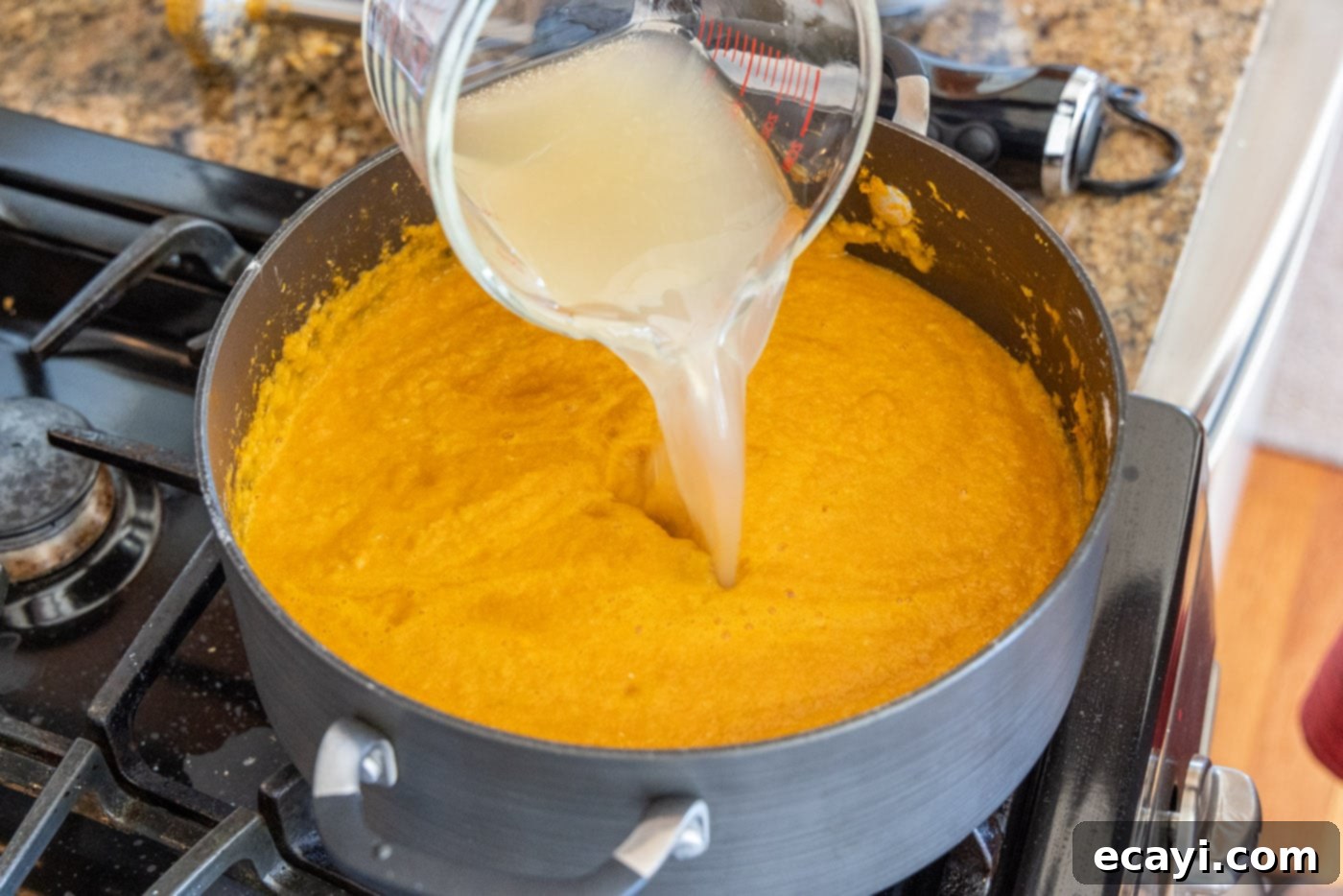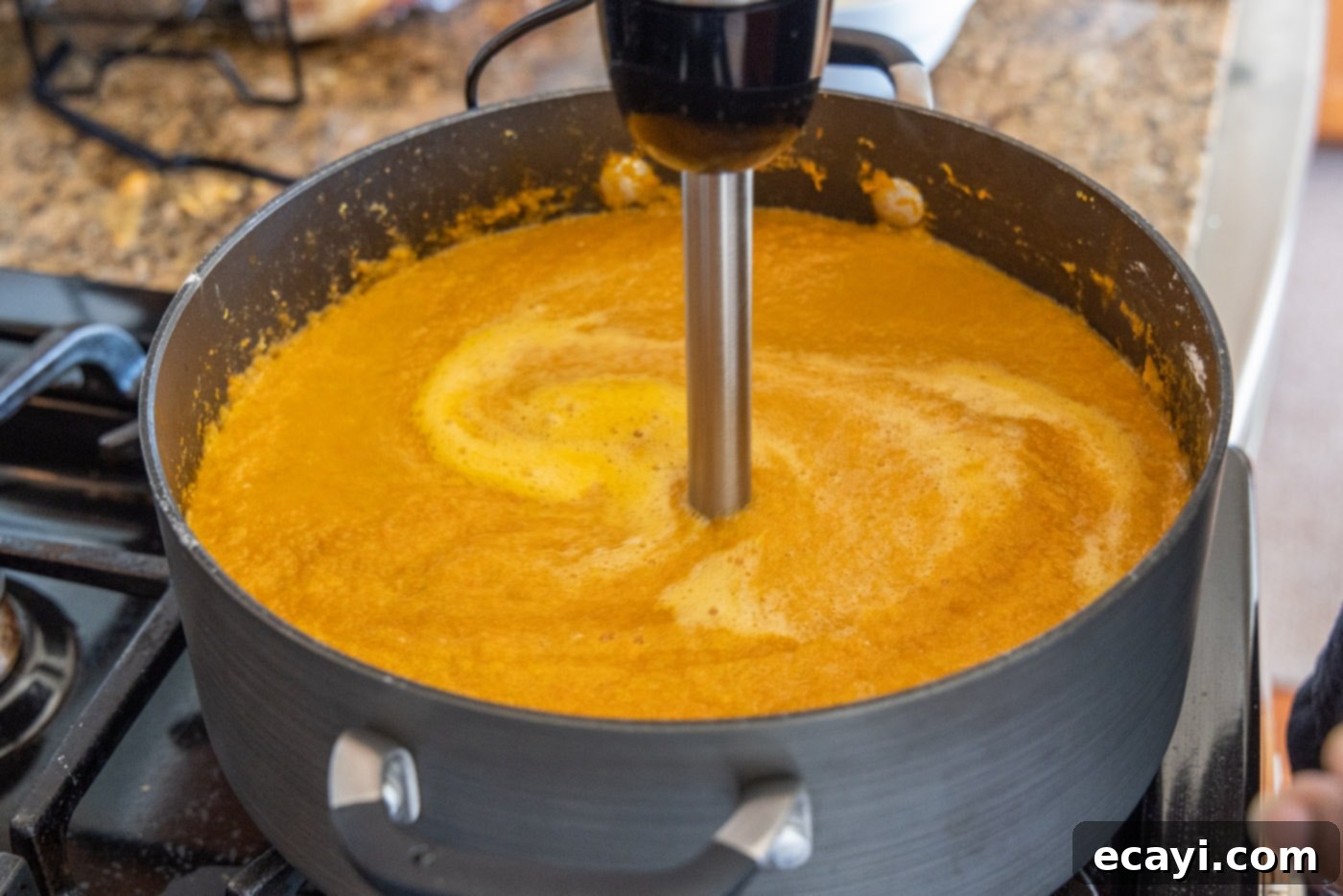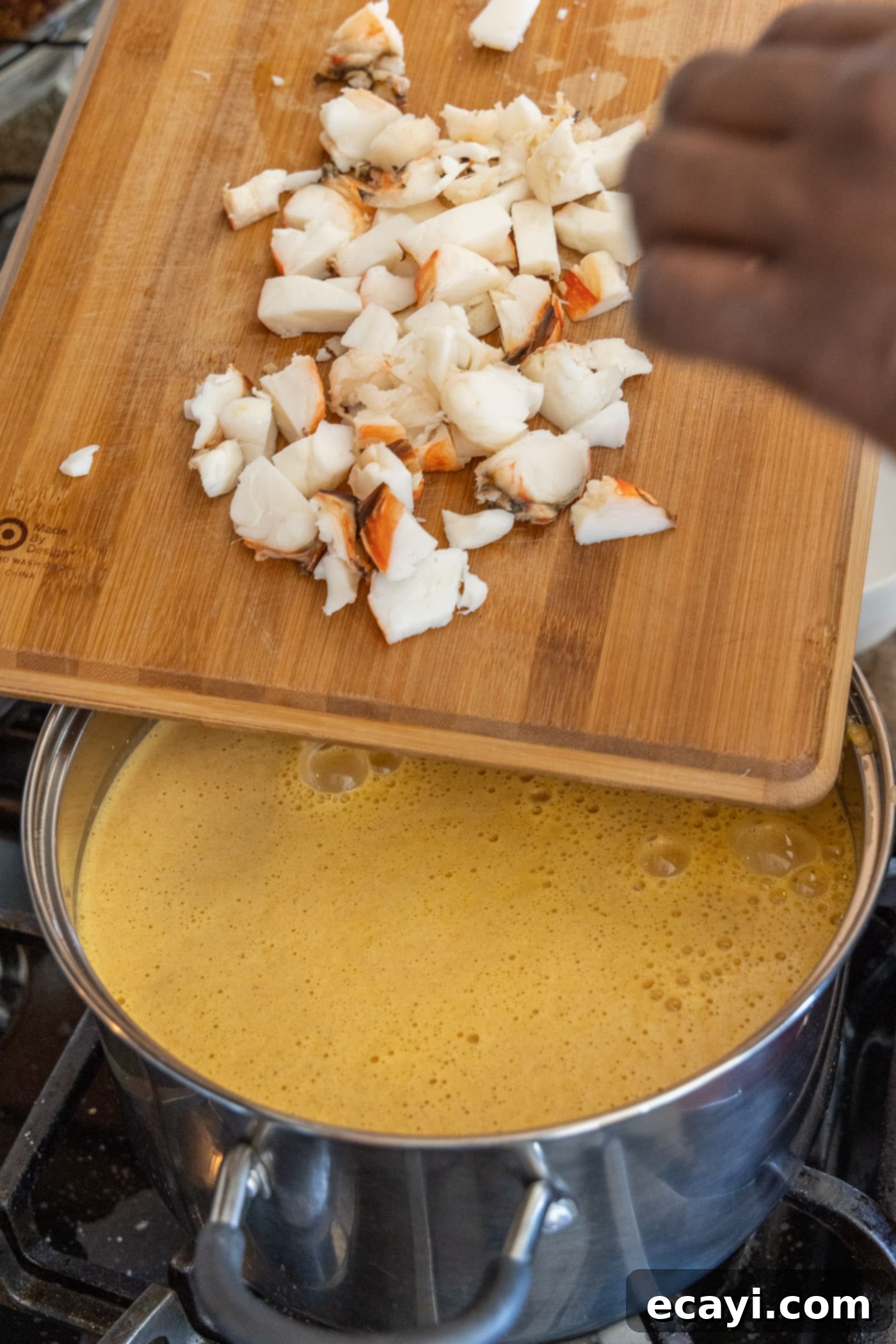Luxurious Homemade Lobster Bisque: Your Guide to a Velvety Smooth & Rich Seafood Delight
Indulge in the unparalleled richness of homemade lobster bisque, a velvety smooth and incredibly flavorful seafood soup. This gourmet delight features a creamy tomato and white wine base, generously studded with succulent, sweet chunks of lobster tails. It’s an elegant starter or a decadent main course that brings the luxury of fine dining right into your kitchen with surprising ease.
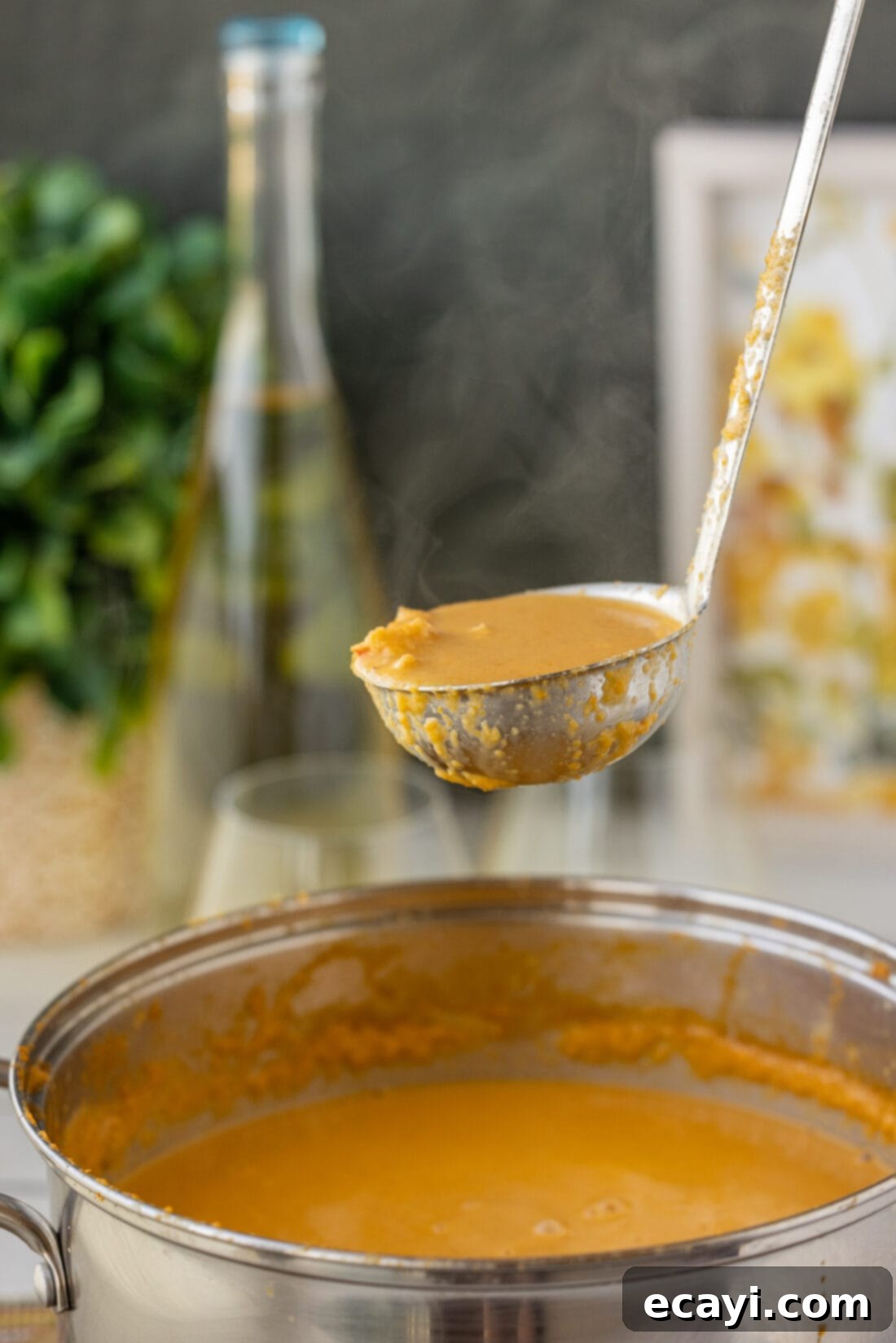
Why This Homemade Lobster Bisque Recipe Stands Out
Lobster bisque is often perceived as a dish reserved for upscale restaurants, but this recipe proves that a truly exceptional version is well within reach for the home cook. What makes this particular recipe shine is its perfect balance of flavor and texture, combined with a straightforward approach that demystifies the gourmet process.
At its heart, this is a creamy seafood soup, meticulously pureed to achieve a signature silky-smooth texture, thanks to the magic of an immersion blender. The depth of flavor comes from a carefully selected medley of ingredients: the inherent sweetness of fresh, buttery lobster tails, aromatic garlic, onion, celery, and carrots forming a classic mirepoix base, bright tomato paste for umami and color, a dry white wine to deglaze and enhance seafood notes, and a thoughtful blend of seasonings that elevates every spoonful. While it may appear sophisticated, the prep work is surprisingly minimal, making it an ideal choice for impressive dinner parties or simply when you crave a touch of luxury at home.

Key Ingredients for the Best Lobster Bisque
Creating a truly memorable lobster bisque begins with high-quality ingredients. While the full list with precise measurements can be found in the printable recipe card at the end of this post, let’s dive into some of the stars of this creamy seafood masterpiece and discuss potential substitutions to ensure your success.
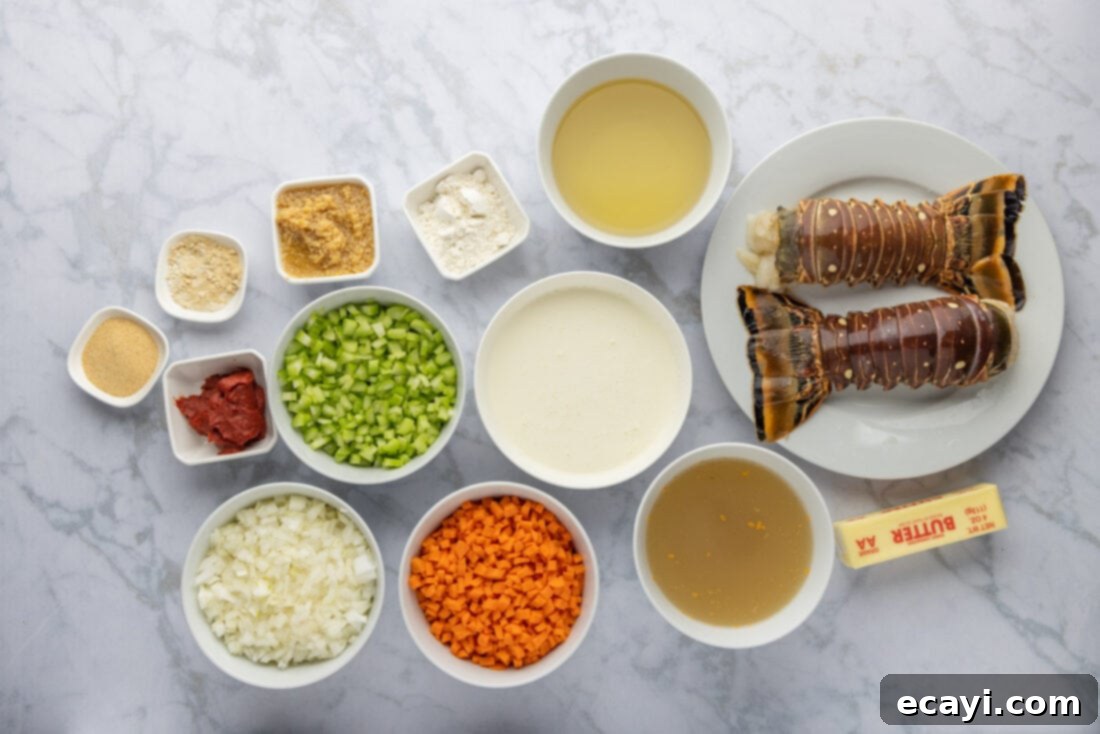
Ingredient Spotlight & Expert Substitution Tips
LOBSTER – The star of the show! You’ll start by preparing your lobster tails. For perfectly cooked, tender lobster every time, we highly recommend checking out our detailed steamed lobster tail recipe, which guarantees delicious results in under 30 minutes. You can use fresh or frozen lobster tails for this recipe. If using frozen, ensure they are fully thawed before cooking. While lobster tails are convenient, you could also use meat from a whole cooked lobster or even pre-cooked lobster meat, adjusting the heating time accordingly to avoid overcooking.
WINE – White wine is a foundational ingredient in many classic bisques, as its acidity and subtle fruit notes beautifully complement and highlight the delicate flavors of the seafood. For the best results, opt for a good quality dry white wine such as Pinot Grigio, Chardonnay, or Sauvignon Blanc. These varieties offer the right balance without overpowering the lobster. If you prefer to avoid alcohol, brandy is a traditional alternative that adds a lovely warmth, or you can use dry sherry. For a completely alcohol-free option, simply substitute with an equal amount of additional seafood stock or a non-alcoholic white wine alternative, though the flavor profile will be slightly different.
CREAM – Heavy cream is crucial for achieving the luxurious richness and thick, velvety consistency that defines a classic lobster bisque. It adds body and a smooth mouthfeel that cannot be replicated by lighter dairy products. If heavy cream is not available or you’re looking to reduce fat slightly, whole milk can be used, but be aware that it will result in a thinner bisque with less intensity. Half-and-half is another option, falling between whole milk and heavy cream in terms of richness. For a dairy-free version, full-fat coconut milk can offer a surprisingly creamy alternative, though it will impart a subtle coconut flavor.
VEGETABLES (Mirepoix) – The base of any great soup, the onion, celery, and carrots, known as mirepoix, provide essential aromatic depth. For this bisque, it’s vital to finely mince these vegetables. This ensures they soften and cook down quickly and completely, integrating seamlessly into the soup without leaving large fibrous chunks, especially if you choose not to strain it. While not strictly necessary, running the minced vegetables through a food processor briefly before sautéing can create an even finer puree, contributing to an ultimately smoother bisque.
STOCK – Seafood stock is the ideal choice for this recipe, as it naturally enhances the oceanic flavors of the lobster. It builds a robust foundation that ties all the ingredients together. If seafood stock is unavailable, you can substitute it with vegetable or chicken stock. However, using these alternatives will alter the overall flavor profile slightly, making the bisque less intensely “seafoody.” If you use chicken stock, ensure it’s low-sodium to control the saltiness of the final dish.
SEASONINGS – Beyond the core ingredients, garlic powder and onion powder amplify the aromatic notes, while salt and black pepper are essential for seasoning to taste. For an added layer of warmth and a hint of color, consider a tiny pinch of cayenne pepper or paprika. These subtle additions can truly elevate the bisque from delicious to unforgettable.
Mastering the Art of Homemade Lobster Bisque: A Step-by-Step Guide
These step-by-step photos and detailed instructions are designed to help you visualize each stage of making this exquisite lobster bisque. For a convenient printable version of the complete recipe, including all measurements and instructions, you can Jump to Recipe at the bottom of this post.
- **Prepare the Lobster:** Begin by cooking your lobster tails according to your preferred method (steaming is highly recommended for tender results). Once cooked, allow them to cool slightly, then carefully remove the meat from the shells. Chop the cooked lobster meat into bite-sized pieces and set aside. This ensures the lobster remains tender and doesn’t overcook when added to the finished bisque.
- **Sauté Garlic and Butter:** In a sturdy Dutch oven or a large, heavy-bottomed pot, melt the unsalted butter over medium heat. Add the minced garlic and sauté for about 1 minute until fragrant. Be careful not to let the garlic brown, as this can lead to a bitter taste. This aromatic base is crucial for the bisque’s flavor.

- **Add Mirepoix:** Introduce the finely minced onion, celery, and carrots to the pot. Stir well to combine with the butter and garlic. Continue to sauté over medium heat for 5-7 minutes, or until the vegetables have softened considerably. Cooking them until tender is key for a smooth bisque.
- **Stir in Tomato Paste:** Add the tomato paste to the softened vegetables. Stir continuously for 2-3 minutes, allowing the tomato paste to cook down and deepen in color. This step, known as caramelizing the tomato paste, builds a rich umami flavor that is essential to the bisque’s profile and contributes to its characteristic color.

- **Create the Roux:** Sprinkle the all-purpose flour evenly over the vegetable and tomato paste mixture. Stir constantly for 1-2 minutes, cooking out the raw flour taste and forming a roux. The roux acts as a thickener, giving the bisque its luxurious body and smooth texture.

- **Deglaze with Wine and Season:** Pour in the dry white wine, stirring vigorously to scrape up any browned bits from the bottom of the pot. These bits are packed with flavor! Add the garlic powder and onion powder, stirring until well combined and the mixture begins to thicken. Allow the wine to simmer for a few minutes, reducing slightly and allowing the alcohol to cook off, leaving behind its concentrated flavor.

- **Add Liquids and Blend to Smoothness:** Gradually pour in the seafood stock and heavy cream, stirring continuously to prevent lumps. Bring the mixture to a gentle simmer. Once simmering, remove the pot from the heat or turn the heat to low. Use an immersion blender directly in the pot to blend the soup until it is completely smooth and creamy. If you don’t have an immersion blender, carefully transfer the hot soup in batches to a regular blender, filling it no more than halfway, and blend until smooth. Remember to remove the center cap of the blender lid and cover with a kitchen towel to allow steam to escape and prevent pressure buildup.


- **Gentle Simmer:** Return the pot to low heat and allow the bisque to simmer, uncovered, for an additional 5 minutes. This gentle simmer allows all the flavors to meld beautifully and for the bisque to thicken slightly to its ideal consistency.
- **Optional Straining for Ultimate Silkiness:** For a truly restaurant-quality, ultra-silky smooth bisque that’s free of any minuscule vegetable fibers, you can optionally strain the bisque through a fine-mesh sieve. This step will remove any remaining tiny chunks or fibrous bits, resulting in an impeccably smooth texture. Keep in mind that straining may reduce the overall volume of your soup slightly. If you choose to strain, add the strained bisque back to the pot.
EXPERT TIP – You can absolutely leave the bisque unstrained! It will still be wonderfully creamy and flavorful after blending, and leaving it as-is retains all the nutrients from the vegetables. Only strain if you are truly aiming for that pristine, glass-smooth consistency.
- **Add Lobster and Serve:** Finally, add the chopped lobster meat back into the soup in the pan. Heat through for just 1-2 minutes, stirring occasionally, until the lobster is warmed through. Avoid boiling or extended heating once the lobster is added to keep it tender and juicy. Serve immediately.

Frequently Asked Questions & Expert Tips for Perfect Lobster Bisque
While dry white wine is a key ingredient that adds significant depth and complexity to lobster bisque, it is certainly possible to make a delicious version without alcohol. The wine’s acidity and nuanced flavor profile help to brighten and enhance the seafood. If you need to omit it, simply substitute the wine with an equal amount of extra seafood stock, vegetable stock, or even a non-alcoholic white wine alternative. This will ensure your bisque still has enough liquid and a good base, though the flavor will be slightly different.
To store leftover lobster bisque, allow it to cool completely to room temperature before transferring it to an airtight container. Refrigerate promptly for optimal freshness and safety. Properly stored, it will keep well in the refrigerator for 1-2 days. Reheat gently over low heat on the stovetop, stirring frequently, to prevent scorching or separating. Avoid boiling the bisque when reheating. While it can technically be frozen, the texture of creamy soups can sometimes change upon thawing, potentially becoming grainy or separating. If freezing, thaw overnight in the refrigerator and whisk well while reheating to restore as much of the original texture as possible.
Absolutely! Frozen lobster tails are a convenient and often more accessible option. Ensure they are fully thawed in the refrigerator before cooking them as per the recipe instructions (e.g., steaming). Using pre-cooked, thawed lobster meat is also possible; just be careful to add it at the very end and heat through gently to avoid making it rubbery.
The primary distinguishing feature of a bisque is its exceptionally smooth, velvety texture and its use of a roux and cream to achieve richness. Traditionally, bisques are made with shellfish (like lobster, crab, or shrimp) and often incorporate a step where the shells are simmered to create a flavorful stock, though this recipe uses ready-made seafood stock for convenience. Unlike a chowder, which is typically chunky and often thickened with potatoes, a bisque is pureed to a fine consistency, offering a more refined and elegant dining experience.
Yes, you can prepare the base of the bisque (up to the point before adding the lobster meat) a day in advance. Store the cooled, blended bisque base in an airtight container in the refrigerator. When ready to serve, gently reheat the base over low heat, stirring frequently. Add the freshly cooked and chopped lobster meat during the last 1-2 minutes of reheating. This method ensures the lobster remains perfectly tender and prevents it from becoming tough if cooked too far in advance.

Elevate Your Lobster Bisque: Perfect Serving Suggestions
This luxurious lobster bisque is incredibly versatile and can be served in various ways to suit your occasion. It makes a sophisticated and impressive appetizer before a multi-course meal, offering a light yet rich start. Alternatively, pair it with a crisp salad and some crusty bread for a truly decadent and satisfying main course. To enhance the experience, consider these garnishing options:
- Croutons or Crusty Bread: Offer warm, crusty bread or garlic bread for dipping, or sprinkle homemade croutons on top for added texture.
- Oyster Crackers: A classic accompaniment, oyster crackers provide a delightful crunch.
- Fresh Herbs: A sprinkle of finely chopped fresh chives, parsley, or tarragon adds a pop of color and a fresh aromatic finish.
- Crème Fraîche or Heavy Cream Drizzle: A small swirl of crème fraîche or a thin drizzle of heavy cream over the top just before serving adds an extra layer of creaminess and visual appeal.
- Touch of Spice: A tiny pinch of paprika or cayenne pepper can be dusted over the top for a hint of color and subtle warmth.
Discover More Delicious Lobster Recipes
If you’re a fan of the rich, sweet flavor of lobster, you’ll love exploring these other incredible recipes that showcase this exquisite seafood:
- Classic Lobster Roll: A New England favorite, packed with fresh lobster meat.
- Creamy Lobster Risotto: An elegant and comforting dish combining rich Arborio rice with tender lobster.
- Perfectly Steamed Lobster Tail: The ultimate guide to preparing tender, juicy lobster tails every time.
- Indulgent Lobster Mac and Cheese: A luxurious twist on a beloved comfort food classic.
I love to bake and cook and share my kitchen experience with all of you! Remembering to come back each day can be tough, that’s why I offer a convenient newsletter every time a new recipe posts. Simply subscribe and start receiving your free daily recipes!

Creamy Lobster Bisque
IMPORTANT – There are often Frequently Asked Questions within the blog post that you may find helpful. Simply scroll back up to read them!
Print It
Pin It
Rate It
Save ItSaved!
Ingredients
- 1 pound lobster tails 2 large tails, cooked
- ½ cup unsalted butter
- ¼ cup minced garlic
- 1 ½ cups finely minced onion
- 1 ½ cups finely minced celery
- 1 ½ cups finely minced carrot
- 2 Tablespoons tomato paste
- 3 Tablespoons all purpose flour
- 1 ½ cups dry white wine such as Pinot Grigio
- 1 Tablespoon garlic powder
- 1 Tablespoon onion powder
- 1 ½ cups seafood stock
- 2 cups heavy whipping cream
Essential Equipment
-
immersion blender
-
Dutch oven
-
Vinyl gloves (Optional, for handling cooked lobster)
Before You Begin: Important Tips for Success
- **Mincing Vegetables for Smoothness:** For the best and smoothest bisque, it is crucial to finely mince the onion, celery, and carrots. Smaller pieces soften and cook much quicker, making them easier to blend into a seamless consistency. For an even finer puree, you can briefly pulse the minced vegetables in a food processor before sautéing them, although this is not strictly necessary.
- **Choosing Your Wine:** Select a good quality dry white wine like Pinot Grigio, Chardonnay, or Sauvignon Blanc. These varieties impart the best flavor without sweetness. If you prefer to avoid alcohol, brandy or dry sherry are excellent substitutes. For an alcohol-free version, use an equivalent amount of seafood, vegetable, or chicken stock.
- **Stock Selection:** While seafood stock is highly recommended for the most authentic flavor, vegetable or chicken stock can be used as alternatives. Be aware that these substitutions may result in a slightly different flavor profile.
- **Yield and Straining:** The recipe yields approximately 6 servings. If you choose to strain the bisque through a fine-mesh sieve for an ultra-silky texture, note that this process will remove some solids and may result in a slightly smaller final portion, potentially closer to 5-6 servings. Omitting the straining step will result in a more robust bisque with all the nutrients, yielding a full 6-8 servings.
Instructions
-
Cook lobster tails as desired (steaming recommended) and chop the meat into bite-sized pieces. Set aside.
-
In a large Dutch oven over medium heat, melt the unsalted butter with the minced garlic for 1 minute until fragrant.
-
Add the finely minced onion, celery, and carrots. Sauté for 5-7 minutes until softened.
-
Stir in the tomato paste and cook for 2-3 minutes, allowing it to deepen in color and flavor.
-
Sprinkle the all-purpose flour over the mixture and cook, stirring continuously, for 1-2 minutes to form a roux and cook out the raw flour taste.
-
Pour in the dry white wine, garlic powder, and onion powder. Stir well, scraping up any browned bits, and allow the wine to simmer and reduce for a few minutes.
-
Add the seafood stock and heavy cream. Bring to a gentle simmer. Remove from heat and use an immersion blender to blend the mixture until completely smooth. (Alternatively, blend in batches in a regular blender, being careful with hot liquids).
-
Turn down the heat to low and allow the bisque to simmer, uncovered, for 5 minutes for flavors to meld.
-
For an exceptionally silky texture, you can optionally strain the bisque through a fine-mesh sieve at this point. This removes any small fibrous bits. If straining, return the strained bisque to the pot.
**Expert Tip:** Leaving the bisque unstrained is perfectly fine and retains all nutrients. Strain only if you prefer a perfectly smooth, restaurant-style consistency.
-
Add the reserved chopped lobster meat to the soup in the pan and heat through gently for 1-2 minutes, stirring occasionally. Do not boil. Serve immediately.
Nutrition Information
The recipes on this blog are tested with a conventional gas oven and gas stovetop. It’s important to note that some ovens, especially as they age, can cook and bake inconsistently. Using an inexpensive oven thermometer can assure you that your oven is truly heating to the proper temperature. If you use a toaster oven or countertop oven, please keep in mind that they may not distribute heat the same as a conventional full sized oven and you may need to adjust your cooking/baking times. In the case of recipes made with a pressure cooker, air fryer, slow cooker, or other appliance, a link to the appliances we use is listed within each respective recipe. For baking recipes where measurements are given by weight, please note that results may not be the same if cups are used instead, and we can’t guarantee success with that method.
